Development of external trade price indices - 3. quarter of 2006
Product Code: e-7232-06
14 November 2006
Development of external trade price indices in the third quarter of 2006
Month-on-month evaluation:
In Q3 2006, import prices in total decreased in average by 0.2% month-on-month, while export prices increased by 0.3%. In harmony with the development of prices on world markets, in case of both import and export prices especially prices of mineral fuels dropped more markedly. On the other hand, as for export prices, an increase was in prices of metals.
The fastest decrease occurred in import prices of ‘mineral fuels, lubricants and related materials’ by -1.8% (mainly petroleum, petroleum products and related materials). Decreasing were also prices of ‘machinery and transport equipment’ by -0.1% (especially office machines and automatic data-processing machines). On the other hand, prices of ‘crude materials, inedible, except fuels‘ increased by 0.6%.
Also in export prices, the most increasing were prices of ’crude materials, inedible, except fuels‘ (+1.4%, mainly metalliferous ores and metal scrap). Prices of ‘machinery and transport equipment’ increased in average by 0.1%. The same as for import prices, also in export prices, as for significant sections in terms of weights, decreasing were most markedly prices of ‘mineral fuels, lubricants and related materials’ (-0.7%, mainly petroleum products).
External trade prices were significantly influenced again mainly by CZK exchange rate to main foreign currencies.
The month-on-month exchange rate index includes two most important currencies from the point of view of Czech external trade, i.e. EUR and USD; m-o-m indices of CZK exchange rates to those currencies were weighted by the weight, which pertains to those currencies in the import price index.
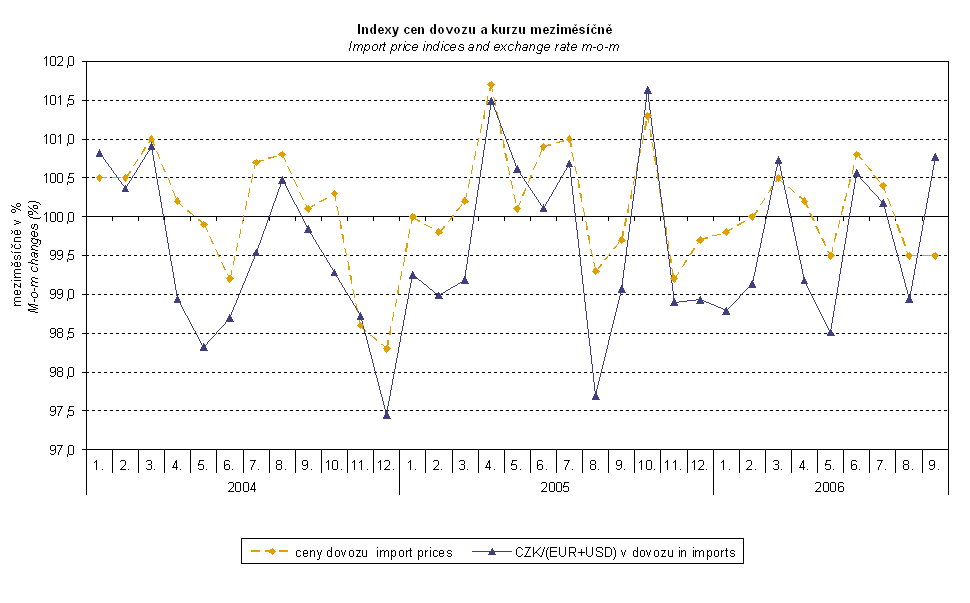

Similarly, when comparing with m-o-m export price indices, m-o-m EUR and USD exchange rate indices were weighted by the weights, which pertain to those currencies in the export price index. It is clear from the above-mentioned graphs that there is a strong correlation between month-on-month external trade price indices and CZK exchange rates to main foreign currencies.
In Q3 2006, the terms of trade value was 100.5%, i.e. by 0.5 p.p. more than in Q2 2006. The highest terms of trade value was in ‘mineral fuels, lubricants and related materials‘ 101.1%. In the most important section in terms of weights ‘machinery and transport equipment’ the terms of trade reached 100.2%, i.e. by 0.2 p.p. less than in the Q2 2006. A negative terms of trade value was only in ‘beverages and tobacco‘ 97.2%.
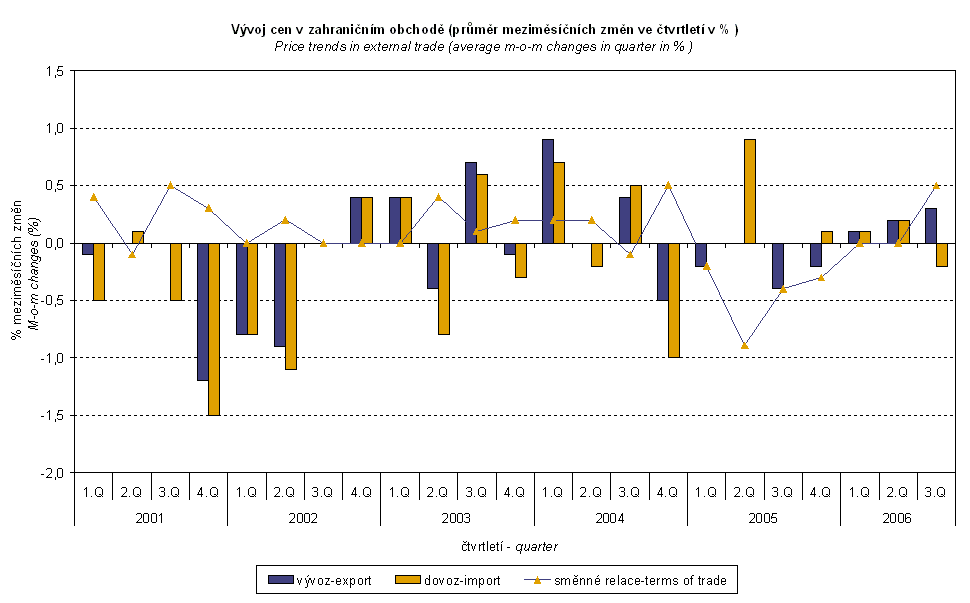
Year-on-year evaluation:
In Q3, similarly as in the month-on-month development, several prevailing influences were observed in the year-on-year external trade price development: decreasing prices of ‘mineral fuels, lubricants and related materials’ on world markets on one hand and, on the other hand, appreciation of CZK exchange rate to main foreign currencies, especially USD, with a different influence on prices of import and export. With regards to a longer time horizon, however, these influences were more marked in the year-on-year development.
Import prices increased in total by 0.5% in Q3 2006 and thus were increasing already from the Q2 2005. However, the growth was by 0.8 p.p. lower than in the previous quarter. The main reason was a marked decrease of the growth in prices of ‘mineral fuels, lubricants and related materials’, which increased only by 6.2%, i.e. by 14.6 p.p. less than in Q2 2006. A marked drop in price growth was mainly among petroleum, petroleum products and gas. Prices of ‘machinery and transport equipment’ dropped by 2.3%; however, it was mainly due to an influence of a stronger CZK.
Export prices recorded in the Q3 2006 an increase by 0.2% and thus increased for the first time since Q1 2005. An important increase was among prices of ‘crude materials, inedible, except fuels’ (+11.1%, especially metalliferous ores) and ‘chemicals and related products‘ (+6.9%, especially plastics and organic chemicals). Against that development, there was an influence of a price decrease of ‘mineral fuels, lubricants and related materials’ -3.5% (especially coal). The same as for import prices, also export prices of ‘machinery and transport equipment’ dropped by -1.5% (mainly road vehicles), again primarily due to the influence of a stronger CZK.
Terms of trade reached the negative value of 99.7% year-on-year in the Q3 2006, which is, however, by 3.0 percentage points more than in the Q2 2006. The increasing values of terms of trade thus reflected both structurally differentiated influence of CZK appreciation at import and export prices as well as gradually improving value of terms of trade of ‘mineral fuels, lubricants and related materials’ (a result of decreasing prices of petroleum on world markets). The terms of trade value was highest in ‘crude materials, inedible, except fuels’ (120.2%), and ‘chemicals and related products‘ (106.4%). On the contrary, the lowest values of terms of trade were already from the Q3 2005 in ‘mineral fuels, lubricants and related materials’ 90.9% (however, it was by 8.5 p.p. higher than in Q2). In ‘machinery and transport equipment’ the value was 100.8%, i.e. by 0.8 percentage point higher than in the Q2 2006.

As it was shown already above, many influences have an impact on external trade prices; among others, it is the CZK exchange rate to foreign currencies. That influence is significant and often even decisive, primarily in the month-on-month expression; however, it has a marked influence also on the level of y-o-y external trade price indices.
The CZSO makes experimental calculations of external trade price indices adjusted for exchange rate influences. The method used does not allow due to many practical reasons to make a 100% exchange rate adjustment (i.e. not all observed deals made in foreign currencies are for the needs of calculation of external trade price indices also reported as such – this share, however, makes only about 25%). Nevertheless, it was verified that even together with an increasing share of reporting in foreign currencies the currency basket remains basically constant. Thus, it can be stated that at the full exchange rate adjustment the differences between the published price indices and price indices that were adjusted would be even bigger.
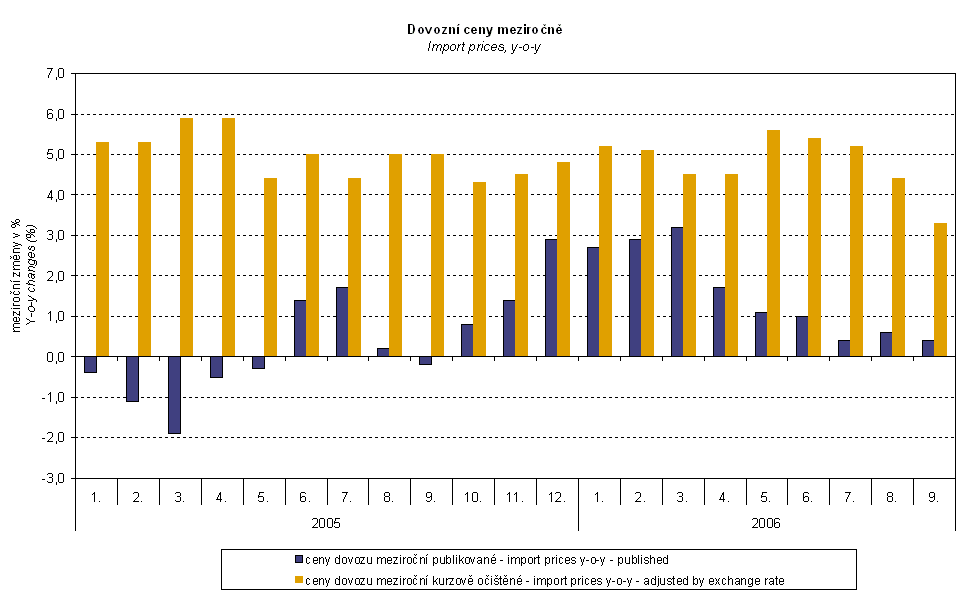
It is clear from the graph that the exchange rate had an important influence on the amount of import price indices. In all months of the observed period, it decreased their amount (altogether, CZK was appreciating against foreign currencies).
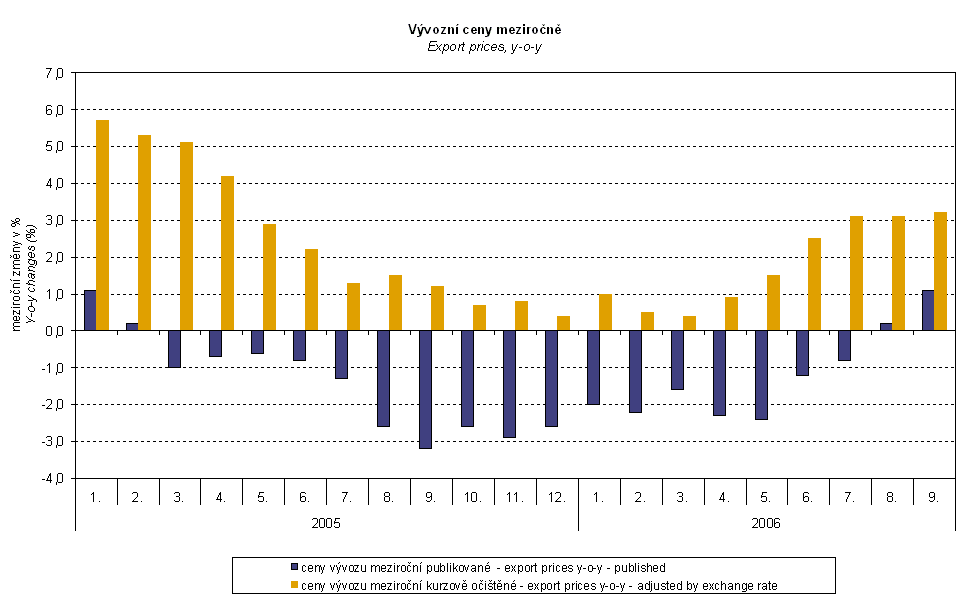
The graph shows that the exchange rate influence had also an important impact on the amount of export price indices. During each month of the observed period, it was decreasing their amount. After elimination of the exchange rate influence, export prices would be increasing during the entire observed period.
Since the share of contracted prices in EUR is higher in exports than in imports, the different development of CZK exchange rate to EUR and USD influences not only the development of export and import price indices, but also their share, i.e. also the terms of trade development.

It is clear from the graph that since May 2006 the exchange rate influence was again increasing the year-on-year terms of trade. It is because from that month CZK was appreciating more to USD than to EUR. A stronger CZK exchange rate is decreasing external trade price indices and (as it was already stated above) if the share of contracted prices in USD is higher in imports than in exports, then the bigger appreciation of CZK to USD resulted in a positive influence on the terms of trade. It is also clear from the graph that even without the exchange rate influence the terms of trade would increase; however, this influence further increased that growth.
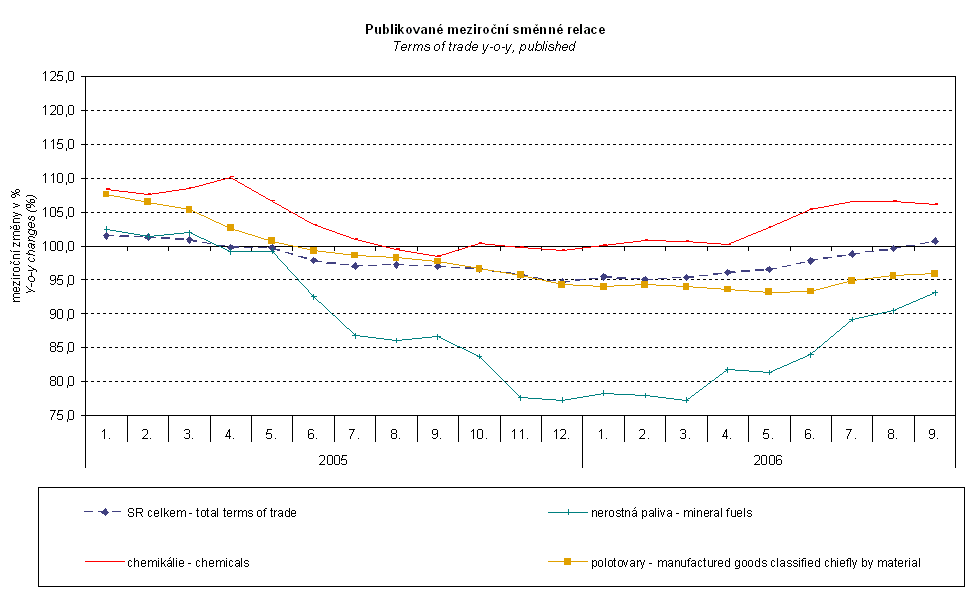
What are other reasons for the gradual increase in y-o-y terms of trade since May 2006? The above-mentioned graph shows sections with the most marked development in terms of trade since the beginning of 2005. They are 'manufactured goods classified chiefly by material' (metals and manufactures of metals in particular) and, most of all, 'mineral fuels, lubricants and related materials' and also chemicals related to them (especially organic chemicals).
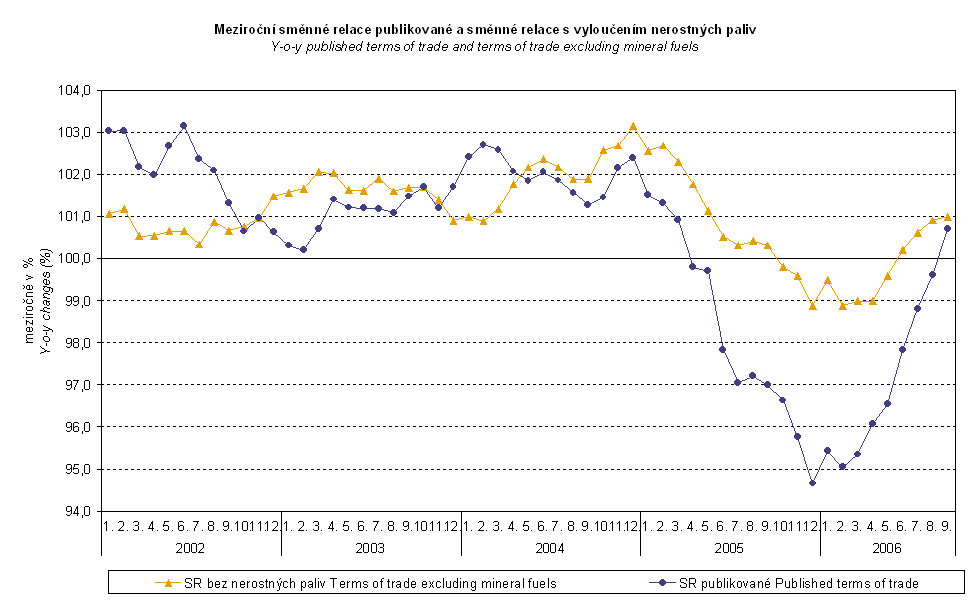
The graph above clearly shows how important is the influence of 'mineral fuels, lubricants and related materials' price development on the terms of trade value. Growth of petroleum prices on world markets was markedly decreasing the terms of trade value; decreasing prices of petroleum during the last months, on the other hand, resulted in a gradual decrease of that influence. Thus, it can be stated that petroleum prices and exchange rate influence were decisive for the terms of trade development.
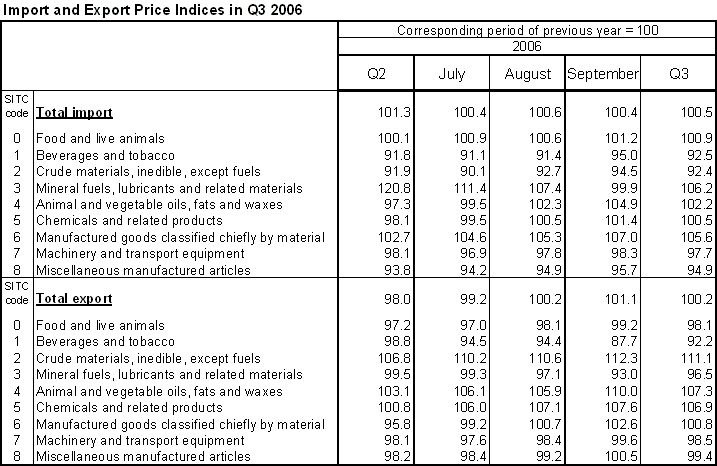
Elaborated by: Jiří Choun, Prices Statistics Department
Director: Jiří Mrázek, phone number: (+420) 27405 2533
